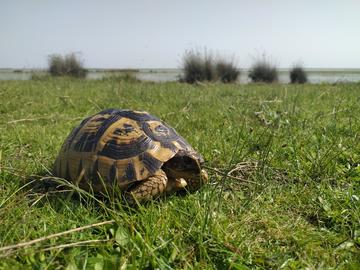New research has revealed that the interactions between some human-induced threats can lead to oversized consequences for threatened groups, particularly in relation to loss of life strategies – a diversity of which is crucial for filling different roles in ecosystems.

A spur thighed tortoise (Testudo graeca), one of the species included in the analyses
Image: Roberto Rodríguez
Researchers investigated six common threats: climate change, habitat disturbance, global trade, overconsumption, pollution, and emerging diseases or invasive species. They studied 230 species of turtles and tortoises and 21 crocodilians – ancient and highly threatened groups – to understand whether the effect of threats jointly was lower (antagonistic), equal (additive), or higher (synergistic) than the sum of the threats separately. Almost half (43%) of the species are at risk from at least three of these different threats.
The study shows that, while most threat interactions are antagonistic, the interaction between emerging diseases or invasive species with other threats has synergistic and additive effects, as well as the combination of habitat degradation and illegal trade. The authors also found global differences, with a high proportion of synergistic interactions in Oceania and oceans worldwide. Senior researcher Associate Professor Rob Salguero-Gómez says:
“Our study shows that biodiversity loss isn’t just about losing species — unfortunately this loss is causing entire branches of the tree of life and the unique ecological strategies those species represent to be fully extirpated. We show that when threats act together, particularly invasive species and trade, their impact is greater than the sum of their parts.”
The results suggest that many conservation assessments could be underestimating the true impact of co-occurring threats. Lead researcher Dr Roberto Rodriguez says:
“Analysing the impact of interactions between threats on species viability is crucial not only to prioritise conservation measures, but also to detect hotspots where conservation efforts are urgently needed.”
Most conservation focuses on numbers of species, but the new study shifts the focus towards preserving the broader diversity of ecological strategies and evolutionary potential — factors which are critical to long-term ecosystem functioning. Co-author Dr Molly Grace says:
“Too often when people speak about conserving biodiversity, what they are really interested in is conserving species richness. This study demonstrates why it is important to recognise that biodiversity encompasses all levels of biological organisation; in addition to the phylogenetic and functional diversity highlighted here, that means genes, communities, and ecosystems too.”
The findings call for conservation frameworks to explicitly incorporate functional and phylogenetic diversity – and in particular protecting species that are evolutionarily distinct or have rare life history strategies. The results also highlight that plans need to consider not just single threats in isolation, but how combinations can accelerate biodiversity erosion. This could reshape how threats are assessed, for example in the IUCN Red List. Co-author Associate Professor Katrina Davis says:
“We’re not just watching turtles and crocodiles disappear — we’re seeing the erosion of millions of years of evolutionary history. Conservation needs to move beyond species counts and focus on protecting the diversity of life’s strategies before it’s too late.”
The researchers now plan to explore groups with different life history structures and conservation contexts, as well as whether the patterns they have seen hold across ecosystems with different levels of human pressure. They also want to understand why some combinations have synergistic effects – a question that could help us predict and mitigate future losses more effectively.
To read more about this research, published in Ecology Letters, visit: https://doi.org/10.1111/ele.70147